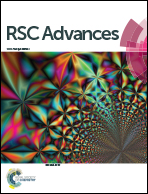Polymer blend nanocomposites based on poly(l-lactic acid), polypropylene and WS2 inorganic nanotubes
Abstract
Tungsten disulphide inorganic nanotubes (INT-WS2) have been incorporated into poly(L-lactic acid) (PLLA)/polypropylene (PP) blends compatibilized with polypropylene-grafted-maleic anhydride (PP-g-MAH), and their effects on the morphology, thermal and mechanical properties of the resulting nanocomposites have been investigated. The nanofillers were uniformly dispersed at the nanoscale via a melt-blending process. The addition of 1.0 wt% INT-WS2 to the PLLA/PP blends hardly affected their thermal stability or their degradation mechanism. Differential scanning calorimetry (DSC) thermograms revealed the nucleating role of INT-WS2 on both polymeric components, reflected not only in an increase in the crystallization temperature from the melt but also in a rise in the crystallization enthalpy and the suppression of the cold-crystallization process; this effect was found to be more pronounced on PLLA and the blends rich in this component. Dynamic mechanical analysis (DMA) measurements demonstrated that the storage modulus of the nanocomposites was higher than those of the binary blends in the whole temperature range studied, ascribed to a synergistic effect of their increased crystallinity and the high INT-WS2 rigidity. This study opens up new perspectives to develop novel INT-WS2/polymer blend hybrid nanocomposites that show great potential for biomedical applications.


 Please wait while we load your content...
Please wait while we load your content...